ESP Lancia Musa 2010 Owner handbook (in English)
[x] Cancel search | Manufacturer: LANCIA, Model Year: 2010, Model line: Musa, Model: Lancia Musa 2010Pages: 218, PDF Size: 3.71 MB
Page 56 of 218
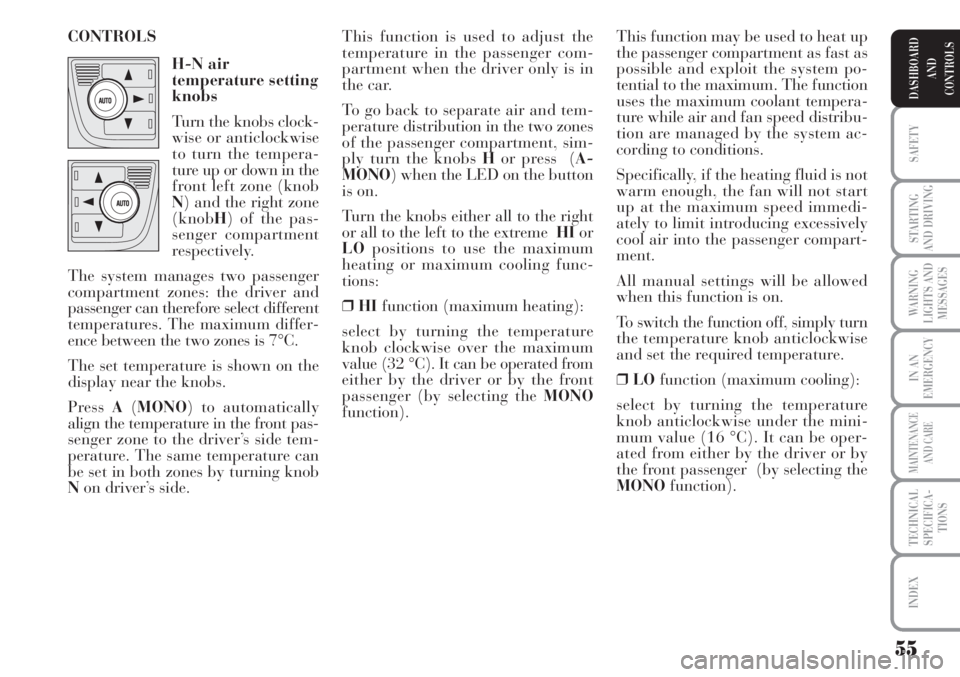
55
SAFETY
STARTING
AND DRIVING
WARNING
LIGHTS AND
MESSAGES
IN AN
EMERGENCY
MAINTENANCE
AND CARE
TECHNICAL
SPECIFICA-
TIONS
INDEX
DASHBOARD
AND
CONTROLS
This function may be used to heat up
the passenger compartment as fast as
possible and exploit the system po-
tential to the maximum. The function
uses the maximum coolant tempera-
ture while air and fan speed distribu-
tion are managed by the system ac-
cording to conditions.
Specifically, if the heating fluid is not
warm enough, the fan will not start
up at the maximum speed immedi-
ately to limit introducing excessively
cool air into the passenger compart-
ment.
All manual settings will be allowed
when this function is on.
To switch the function off, simply turn
the temperature knob anticlockwise
and set the required temperature.
❒LOfunction (maximum cooling):
select by turning the temperature
knob anticlockwise under the mini-
mum value (16 °C). It can be oper-
ated from either by the driver or by
the front passenger (by selecting the
MONOfunction). This function is used to adjust the
temperature in the passenger com-
partment when the driver only is in
the car.
To go back to separate air and tem-
perature distribution in the two zones
of the passenger compartment, sim-
ply turn the knobs Hor press (A-
MONO) when the LED on the button
is on.
Turn the knobs either all to the right
or all to the left to the extreme HIor
LOpositions to use the maximum
heating or maximum cooling func-
tions:
❒HIfunction (maximum heating):
select by turning the temperature
knob clockwise over the maximum
value (32 °C). It can be operated from
either by the driver or by the front
passenger (by selecting the MONO
function). CONTROLS
H-N air
temperature setting
knobs
Turn the knobs clock-
wise or anticlockwise
to turn the tempera-
ture up or down in the
front left zone (knob
N) and the right zone
(knobH) of the pas-
senger compartment
respectively.
The system manages two passenger
compartment zones: the driver and
passenger can therefore select different
temperatures. The maximum differ-
ence between the two zones is 7°C.
The set temperature is shown on the
display near the knobs.
Press A(MONO) to automatically
align the temperature in the front pas-
senger zone to the driver’s side tem-
perature. The same temperature can
be set in both zones by turning knob
Non driver’s side.
Page 58 of 218
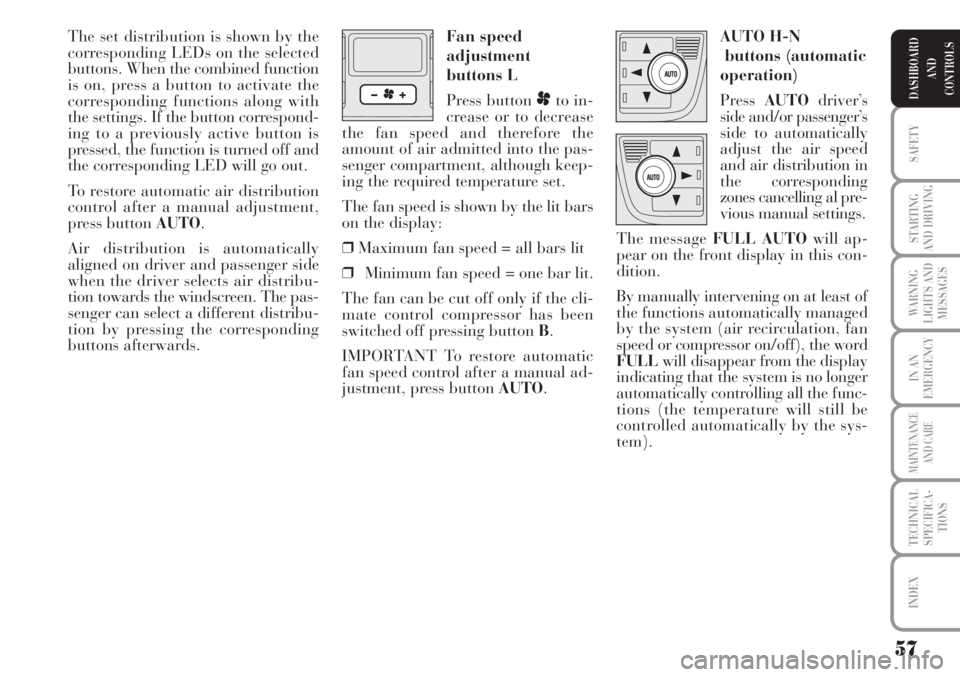
57
SAFETY
STARTING
AND DRIVING
WARNING
LIGHTS AND
MESSAGES
IN AN
EMERGENCY
MAINTENANCE
AND CARE
TECHNICAL
SPECIFICA-
TIONS
INDEX
DASHBOARD
AND
CONTROLS
The set distribution is shown by the
corresponding LEDs on the selected
buttons. When the combined function
is on, press a button to activate the
corresponding functions along with
the settings. If the button correspond-
ing to a previously active button is
pressed, the function is turned off and
the corresponding LED will go out.
To restore automatic air distribution
control after a manual adjustment,
press button AUTO.
Air distribution is automatically
aligned on driver and passenger side
when the driver selects air distribu-
tion towards the windscreen. The pas-
senger can select a different distribu-
tion by pressing the corresponding
buttons afterwards.AUTO H-N
buttons (automatic
operation)
Press AUTOdriver’s
side and/or passenger’s
side to automatically
adjust the air speed
and air distribution in
the corresponding
zones cancelling al pre-
vious manual settings.
The message FULL AUTOwill ap-
pear on the front display in this con-
dition.
By manually intervening on at least of
the functions automatically managed
by the system (air recirculation, fan
speed or compressor on/off), the word
FULLwill disappear from the display
indicating that the system is no longer
automatically controlling all the func-
tions (the temperature will still be
controlled automatically by the sys-
tem). Fan speed
adjustment
buttons L
Press button
pto in-
crease or to decrease
the fan speed and therefore the
amount of air admitted into the pas-
senger compartment, although keep-
ing the required temperature set.
The fan speed is shown by the lit bars
on the display:
❒Maximum fan speed = all bars lit
❒Minimum fan speed = one bar lit.
The fan can be cut off only if the cli-
mate control compressor has been
switched off pressing button B.
IMPORTANT To restore automatic
fan speed control after a manual ad-
justment, press button AUTO.
Page 60 of 218
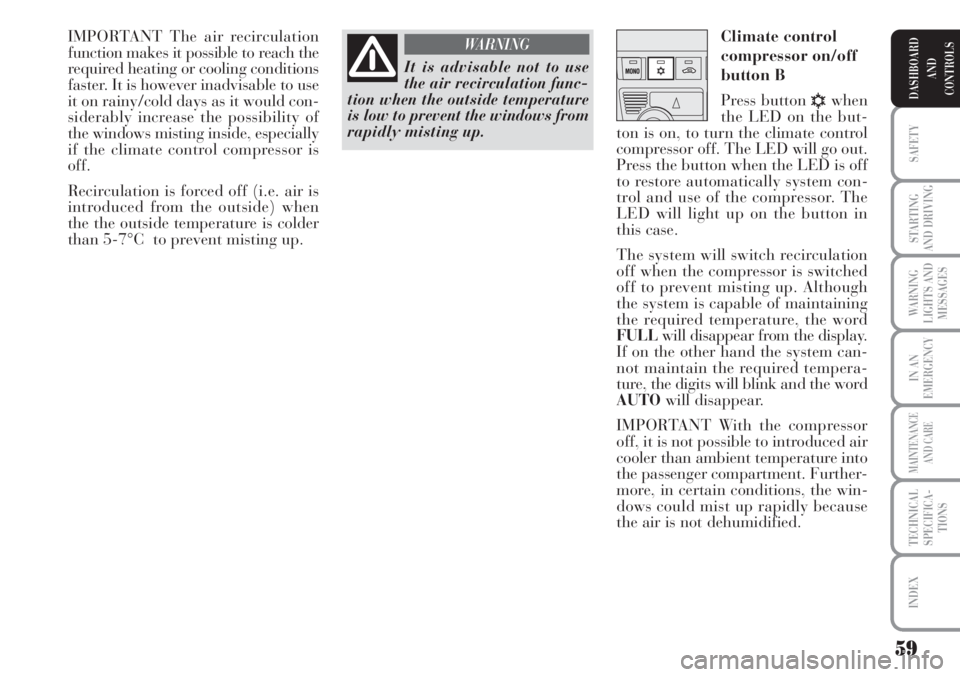
59
SAFETY
STARTING
AND DRIVING
WARNING
LIGHTS AND
MESSAGES
IN AN
EMERGENCY
MAINTENANCE
AND CARE
TECHNICAL
SPECIFICA-
TIONS
INDEX
DASHBOARD
AND
CONTROLS
IMPORTANT The air recirculation
function makes it possible to reach the
required heating or cooling conditions
faster. It is however inadvisable to use
it on rainy/cold days as it would con-
siderably increase the possibility of
the windows misting inside, especially
if the climate control compressor is
off.
Recirculation is forced off (i.e. air is
introduced from the outside) when
the the outside temperature is colder
than 5-7°C to prevent misting up.Climate control
compressor on/off
button B
Press button
√when
the LED on the but-
ton is on, to turn the climate control
compressor off. The LED will go out.
Press the button when the LED is off
to restore automatically system con-
trol and use of the compressor. The
LED will light up on the button in
this case.
The system will switch recirculation
off when the compressor is switched
off to prevent misting up. Although
the system is capable of maintaining
the required temperature, the word
FULLwill disappear from the display.
If on the other hand the system can-
not maintain the required tempera-
ture, the digits will blink and the word
AUTOwill disappear.
IMPORTANT With the compressor
off, it is not possible to introduced air
cooler than ambient temperature into
the passenger compartment. Further-
more, in certain conditions, the win-
dows could mist up rapidly because
the air is not dehumidified.
It is advisable not to use
the air recirculation func-
tion when the outside temperature
is low to prevent the windows from
rapidly misting up.
WARNING
Page 61 of 218
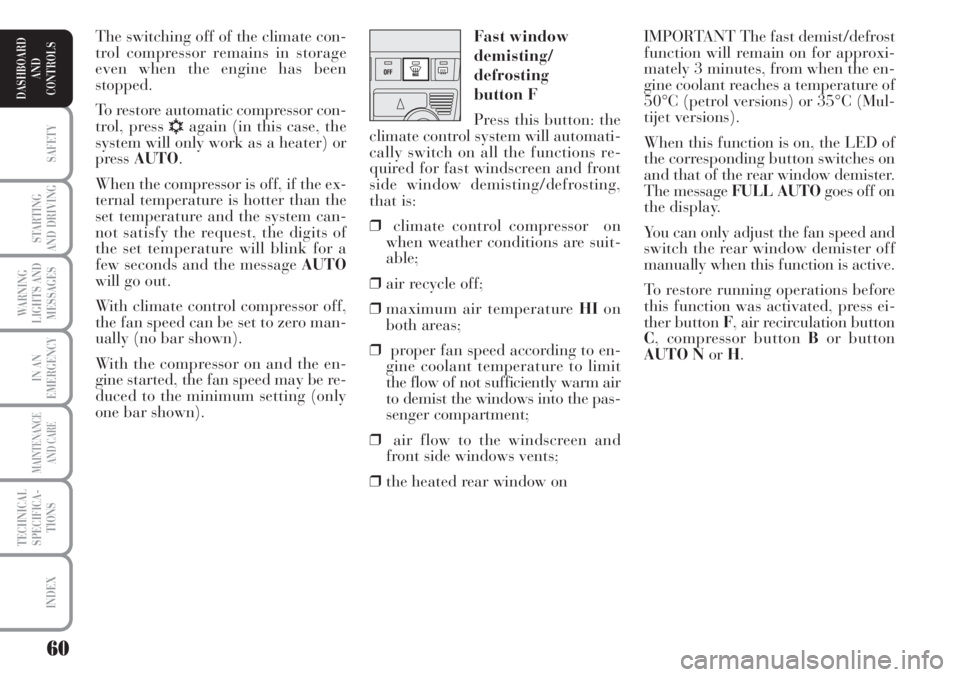
60
SAFETY
STARTING
AND DRIVING
WARNING
LIGHTS AND
MESSAGES
IN AN
EMERGENCY
MAINTENANCE
AND CARE
TECHNICAL
SPECIFICA-
TIONS
INDEX
DASHBOARD
AND
CONTROLS
IMPORTANT The fast demist/defrost
function will remain on for approxi-
mately 3 minutes, from when the en-
gine coolant reaches a temperature of
50°C (petrol versions) or 35°C (Mul-
tijet versions).
When this function is on, the LED of
the corresponding button switches on
and that of the rear window demister.
The message FULL AUTOgoes off on
the display.
You can only adjust the fan speed and
switch the rear window demister off
manually when this function is active.
To restore running operations before
this function was activated, press ei-
ther button F, air recirculation button
C, compressor button Bor button
AUTO NorH. Fast window
demisting/
defrosting
button F
Press this button: the
climate control system will automati-
cally switch on all the functions re-
quired for fast windscreen and front
side window demisting/defrosting,
that is:
❒climate control compressor on
when weather conditions are suit-
able;
❒air recycle off;
❒maximum air temperature HIon
both areas;
❒proper fan speed according to en-
gine coolant temperature to limit
the flow of not sufficiently warm air
to demist the windows into the pas-
senger compartment;
❒air flow to the windscreen and
front side windows vents;
❒the heated rear window on The switching off of the climate con-
trol compressor remains in storage
even when the engine has been
stopped.
To restore automatic compressor con-
trol, press
√again (in this case, the
system will only work as a heater) or
press AUTO.
When the compressor is off, if the ex-
ternal temperature is hotter than the
set temperature and the system can-
not satisfy the request, the digits of
the set temperature will blink for a
few seconds and the message AUTO
will go out.
With climate control compressor off,
the fan speed can be set to zero man-
ually (no bar shown).
With the compressor on and the en-
gine started, the fan speed may be re-
duced to the minimum setting (only
one bar shown).
Page 62 of 218
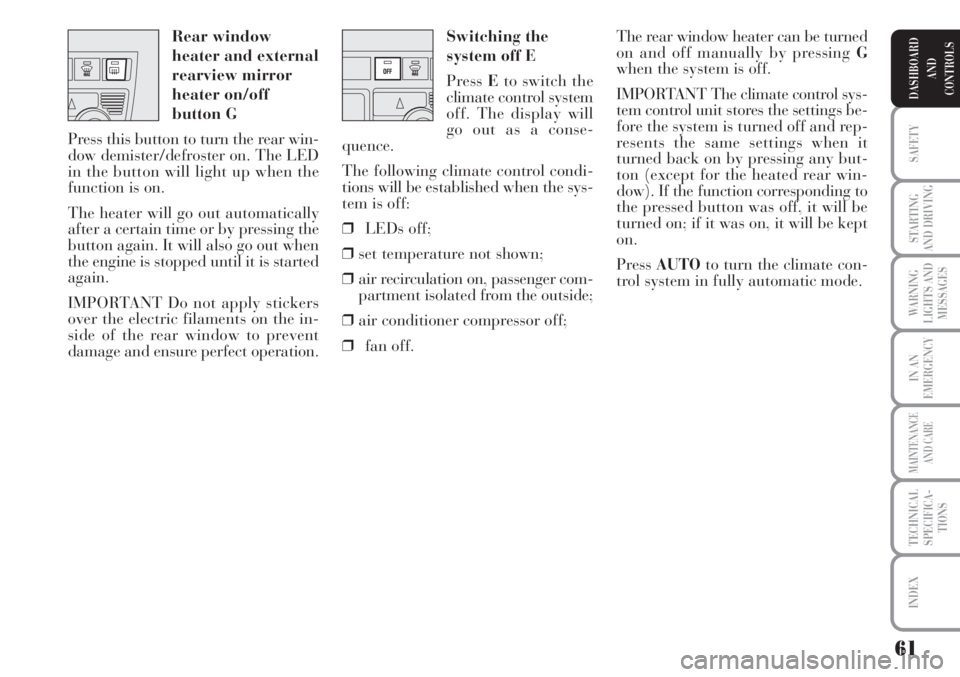
61
SAFETY
STARTING
AND DRIVING
WARNING
LIGHTS AND
MESSAGES
IN AN
EMERGENCY
MAINTENANCE
AND CARE
TECHNICAL
SPECIFICA-
TIONS
INDEX
DASHBOARD
AND
CONTROLS
Switching the
system off E
Press Eto switch the
climate control system
off. The display will
go out as a conse-
quence.
The following climate control condi-
tions will be established when the sys-
tem is off:
❒LEDs off;
❒set temperature not shown;
❒air recirculation on, passenger com-
partment isolated from the outside;
❒air conditioner compressor off;
❒fan off.The rear window heater can be turned
on and off manually by pressing G
when the system is off.
IMPORTANT The climate control sys-
tem control unit stores the settings be-
fore the system is turned off and rep-
resents the same settings when it
turned back on by pressing any but-
ton (except for the heated rear win-
dow). If the function corresponding to
the pressed button was off, it will be
turned on; if it was on, it will be kept
on.
Press AUTOto turn the climate con-
trol system in fully automatic mode. Rear window
heater and external
rearview mirror
heater on/off
button G
Press this button to turn the rear win-
dow demister/defroster on. The LED
in the button will light up when the
function is on.
The heater will go out automatically
after a certain time or by pressing the
button again. It will also go out when
the engine is stopped until it is started
again.
IMPORTANT Do not apply stickers
over the electric filaments on the in-
side of the rear window to prevent
damage and ensure perfect operation.
Page 69 of 218
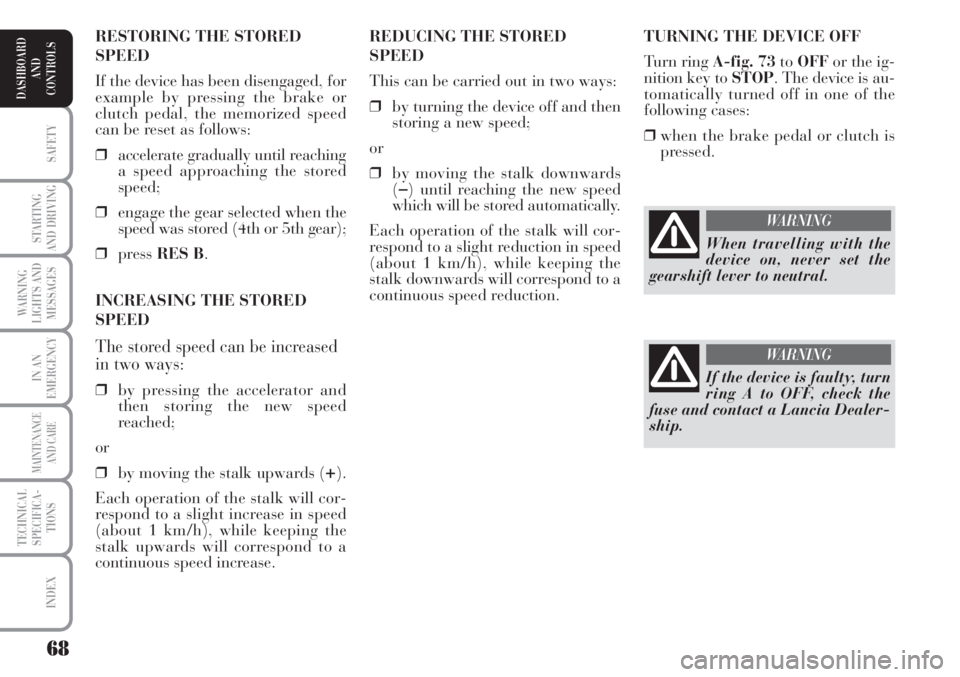
68
SAFETY
STARTING
AND DRIVING
WARNING
LIGHTS AND
MESSAGES
IN AN
EMERGENCY
MAINTENANCE
AND CARE
TECHNICAL
SPECIFICA-
TIONS
INDEX
DASHBOARD
AND
CONTROLS
TURNING THE DEVICE OFF
Turn ring A-fig. 73toOFFor the ig-
nition key to STOP. The device is au-
tomatically turned off in one of the
following cases:
❒when the brake pedal or clutch is
pressed. REDUCING THE STORED
SPEED
This can be carried out in two ways:
❒by turning the device off and then
storing a new speed;
or
❒by moving the stalk downwards
(
–) until reaching the new speed
which will be stored automatically.
Each operation of the stalk will cor-
respond to a slight reduction in speed
(about 1 km/h), while keeping the
stalk downwards will correspond to a
continuous speed reduction. RESTORING THE STORED
SPEED
If the device has been disengaged, for
example by pressing the brake or
clutch pedal, the memorized speed
can be reset as follows:
❒accelerate gradually until reaching
a speed approaching the stored
speed;
❒engage the gear selected when the
speed was stored (4th or 5th gear);
❒press RES B.
INCREASING THE STORED
SPEED
The stored speed can be increased
in two ways:
❒by pressing the accelerator and
then storing the new speed
reached;
or
❒by moving the stalk upwards (
+).
Each operation of the stalk will cor-
respond to a slight increase in speed
(about 1 km/h), while keeping the
stalk upwards will correspond to a
continuous speed increase.
When travelling with the
device on, never set the
gearshift lever to neutral.
WARNING
If the device is faulty, turn
ring A to OFF, check the
fuse and contact a Lancia Dealer-
ship.
WARNING
Page 80 of 218
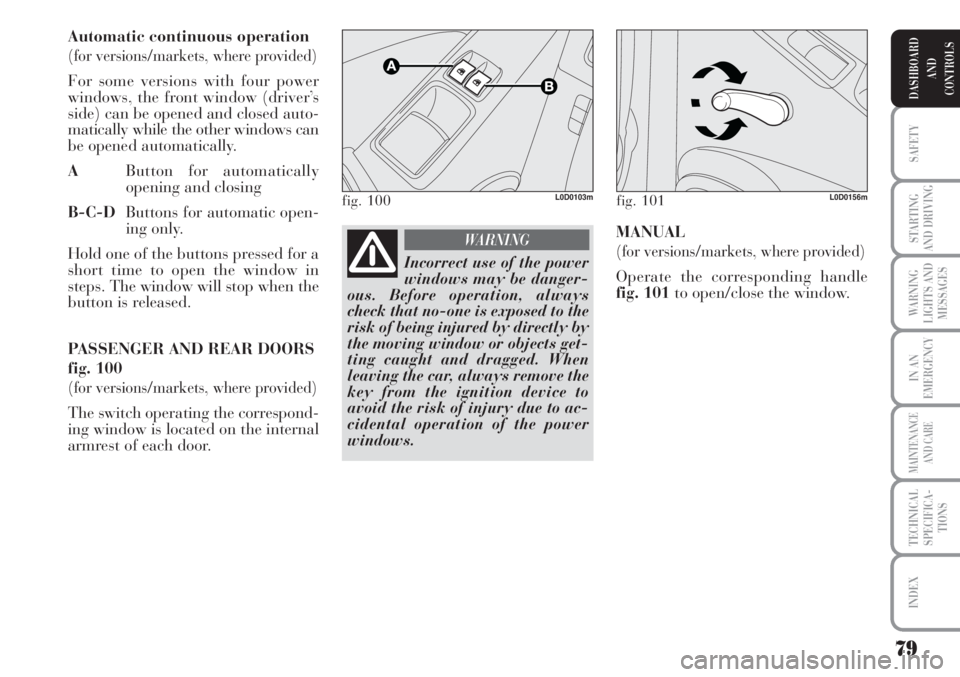
79
SAFETY
STARTING
AND DRIVING
WARNING
LIGHTS AND
MESSAGES
IN AN
EMERGENCY
MAINTENANCE
AND CARE
TECHNICAL
SPECIFICA-
TIONS
INDEX
DASHBOARD
AND
CONTROLS
Automatic continuous operation
(for versions/markets, where provided)
For some versions with four power
windows, the front window (driver’s
side) can be opened and closed auto-
matically while the other windows can
be opened automatically.
AButton for automatically
opening and closing
B-C-DButtons for automatic open-
ing only.
Hold one of the buttons pressed for a
short time to open the window in
steps. The window will stop when the
button is released.
PASSENGER AND REAR DOORS
fig. 100
(for versions/markets, where provided)
The switch operating the correspond-
ing window is located on the internal
armrest of each door.
fig. 100L0D0103m
Incorrect use of the power
windows may be danger-
ous. Before operation, always
check that no-one is exposed to the
risk of being injured by directly by
the moving window or objects get-
ting caught and dragged. When
leaving the car, always remove the
key from the ignition device to
avoid the risk of injury due to ac-
cidental operation of the power
windows.
WARNING
fig. 101L0D0156m
MANUAL
(for versions/markets, where provided)
Operate the corresponding handle
fig. 101to open/close the window.
Page 82 of 218
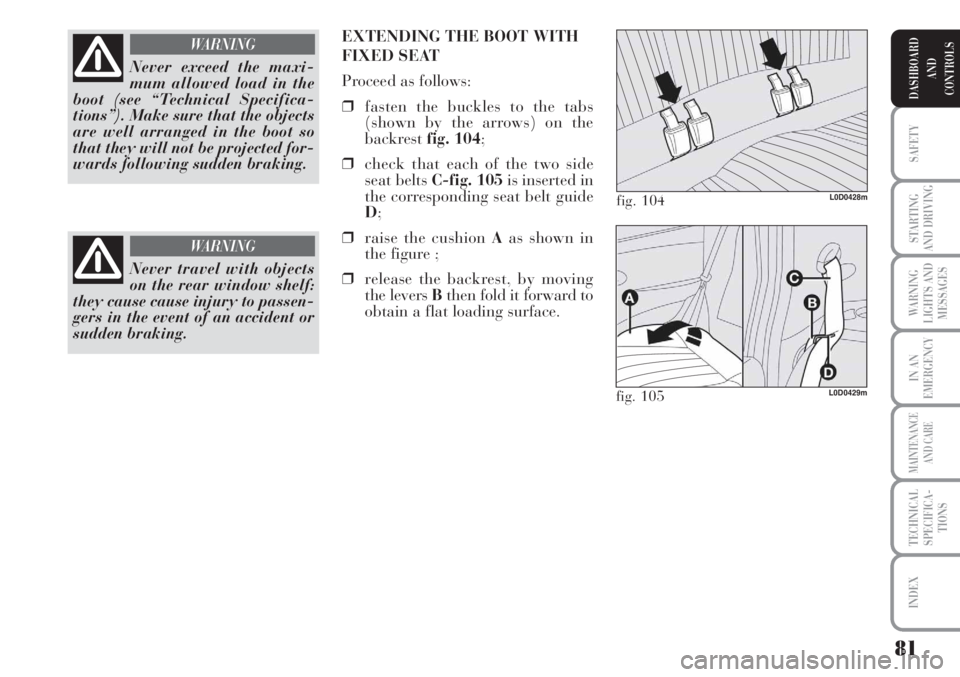
81
SAFETY
STARTING
AND DRIVING
WARNING
LIGHTS AND
MESSAGES
IN AN
EMERGENCY
MAINTENANCE
AND CARE
TECHNICAL
SPECIFICA-
TIONS
INDEX
DASHBOARD
AND
CONTROLS
Never exceed the maxi-
mum allowed load in the
boot (see “Technical Specifica-
tions”). Make sure that the objects
are well arranged in the boot so
that they will not be projected for-
wards following sudden braking.
WARNING
Never travel with objects
on the rear window shelf:
they cause cause injury to passen-
gers in the event of an accident or
sudden braking.
WARNING
EXTENDING THE BOOT WITH
FIXED SEAT
Proceed as follows:
❒fasten the buckles to the tabs
(shown by the arrows) on the
backrestfig. 104;
❒check that each of the two side
seat belts C-fig. 105is inserted in
the corresponding seat belt guide
D;
❒raise the cushion Aas shown in
the figure ;
❒release the backrest, by moving
the levers Bthen fold it forward to
obtain a flat loading surface.
fig. 104L0D0428m
fig. 105L0D0429m
Page 90 of 218
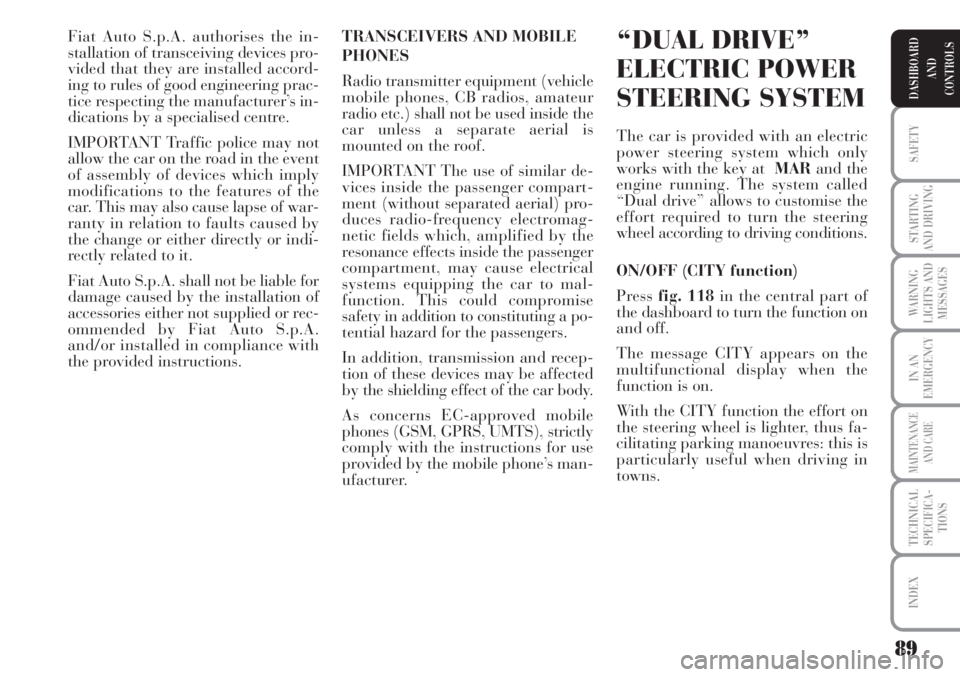
89
SAFETY
STARTING
AND DRIVING
WARNING
LIGHTS AND
MESSAGES
IN AN
EMERGENCY
MAINTENANCE
AND CARE
TECHNICAL
SPECIFICA-
TIONS
INDEX
DASHBOARD
AND
CONTROLS
Fiat Auto S.p.A. authorises the in-
stallation of transceiving devices pro-
vided that they are installed accord-
ing to rules of good engineering prac-
tice respecting the manufacturer’s in-
dications by a specialised centre.
IMPORTANT Traffic police may not
allow the car on the road in the event
of assembly of devices which imply
modifications to the features of the
car. This may also cause lapse of war-
ranty in relation to faults caused by
the change or either directly or indi-
rectly related to it.
Fiat Auto S.p.A. shall not be liable for
damage caused by the installation of
accessories either not supplied or rec-
ommended by Fiat Auto S.p.A.
and/or installed in compliance with
the provided instructions.“DUAL DRIVE”
ELECTRIC POWER
STEERING SYSTEM
The car is provided with an electric
power steering system which only
works with the key at MARand the
engine running. The system called
“Dual drive” allows to customise the
effort required to turn the steering
wheel according to driving conditions.
ON/OFF (CITY function)
Press fig. 118in the central part of
the dashboard to turn the function on
and off.
The message CITY appears on the
multifunctional display when the
function is on.
With the CITY function the effort on
the steering wheel is lighter, thus fa-
cilitating parking manoeuvres: this is
particularly useful when driving in
towns. TRANSCEIVERS AND MOBILE
PHONES
Radio transmitter equipment (vehicle
mobile phones, CB radios, amateur
radio etc.) shall not be used inside the
car unless a separate aerial is
mounted on the roof.
IMPORTANT The use of similar de-
vices inside the passenger compart-
ment (without separated aerial) pro-
duces radio-frequency electromag-
netic fields which, amplified by the
resonance effects inside the passenger
compartment, may cause electrical
systems equipping the car to mal-
function. This could compromise
safety in addition to constituting a po-
tential hazard for the passengers.
In addition, transmission and recep-
tion of these devices may be affected
by the shielding effect of the car body.
As concerns EC-approved mobile
phones (GSM, GPRS, UMTS), strictly
comply with the instructions for use
provided by the mobile phone’s man-
ufacturer.
Page 93 of 218
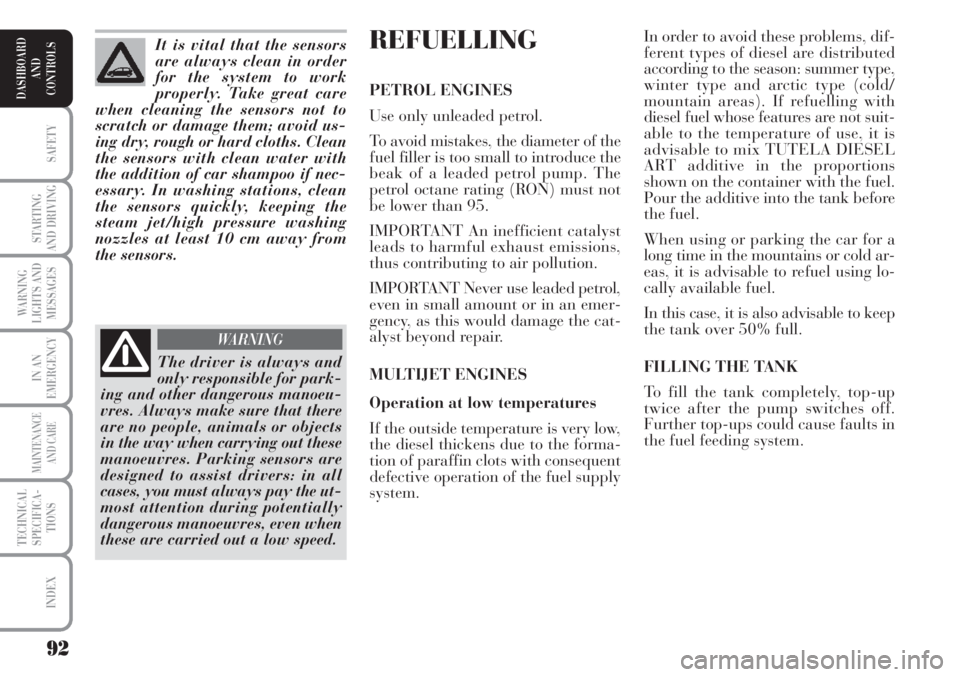
92
SAFETY
STARTING
AND DRIVING
WARNING
LIGHTS AND
MESSAGES
IN AN
EMERGENCY
MAINTENANCE
AND CARE
TECHNICAL
SPECIFICA-
TIONS
INDEX
DASHBOARD
AND
CONTROLS
REFUELLING
PETROL ENGINES
Use only unleaded petrol.
To avoid mistakes, the diameter of the
fuel filler is too small to introduce the
beak of a leaded petrol pump. The
petrol octane rating (RON) must not
be lower than 95.
IMPORTANT An inefficient catalyst
leads to harmful exhaust emissions,
thus contributing to air pollution.
IMPORTANT Never use leaded petrol,
even in small amount or in an emer-
gency, as this would damage the cat-
alyst beyond repair.
MULTIJET ENGINES
Operation at low temperatures
If the outside temperature is very low,
the diesel thickens due to the forma-
tion of paraffin clots with consequent
defective operation of the fuel supply
system.In order to avoid these problems, dif-
ferent types of diesel are distributed
according to the season: summer type,
winter type and arctic type (cold/
mountain areas). If refuelling with
diesel fuel whose features are not suit-
able to the temperature of use, it is
advisable to mix TUTELA DIESEL
ART additive in the proportions
shown on the container with the fuel.
Pour the additive into the tank before
the fuel.
When using or parking the car for a
long time in the mountains or cold ar-
eas, it is advisable to refuel using lo-
cally available fuel.
In this case, it is also advisable to keep
the tank over 50% full.
FILLING THE TANK
To fill the tank completely, top-up
twice after the pump switches off.
Further top-ups could cause faults in
the fuel feeding system. It is vital that the sensors
are always clean in order
for the system to work
properly. Take great care
when cleaning the sensors not to
scratch or damage them; avoid us-
ing dry, rough or hard cloths. Clean
the sensors with clean water with
the addition of car shampoo if nec-
essary. In washing stations, clean
the sensors quickly, keeping the
steam jet/high pressure washing
nozzles at least 10 cm away from
the sensors.
The driver is always and
only responsible for park-
ing and other dangerous manoeu-
vres. Always make sure that there
are no people, animals or objects
in the way when carrying out these
manoeuvres. Parking sensors are
designed to assist drivers: in all
cases, you must always pay the ut-
most attention during potentially
dangerous manoeuvres, even when
these are carried out a low speed.
WARNING